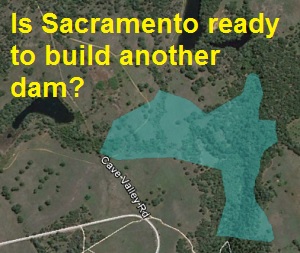If you’ve ever served on any committee you know that the topics of conversation can veer off course to peripheral discussions. At the last San Juan Water District Drought Committee meeting one of the participants threw out for discussion the possibility of San Juan Water District building their own dam for water storage. While the prospect of a “mini-Auburn Dam” floated around, there was also discussions concerning prioritizing water use, tackling excessive irrigation by Home Owners Associations and the possibility of organizing a group of volunteers to spread the message of water efficient landscapes.
Does the Sacramento metropolitan region need a new dam?
The build up to a new regional dam and reservoir discussion resulted from the usual concerns the area is constantly grappling with –
- Population is increasing but we haven’t developed any new water resources.
- Environmental considerations are governing more of the water releases at Folsom Lake.
- Is the current drought and potential climate change the new normal for the region?
- Can the Bureau of Reclamation be depended upon to manage Folsom to meet the growing water demand in the region?
Many water districts own dams and reservoirs
There are numerous privately held reservoirs built by irrigation and municipal utility districts throughout California. The Turlock Irrigation District owns Don Pedro Dam. That the San Juan Water District, in concert with other water agencies, could possibly spear head such a project is not unrealistic. While the era of the big reservoir projects like Auburn Dam may be dead, there’s no reason that a series of small dams might provide additional water security with little harm to the environment.
A mini-Auburn dam
A dam on Knickerbocker Creek in the Auburn SRA at elevation 1390 feet would create a reservoir approximately the area outlined in blue in the image.
To the west of Cool, CA, there are a couple of irrigation ponds that were constructed to serve the mining and ranching operations decades ago. This area is now within the Auburn State Recreation Area created when the Auburn Dam was being built. (See One earth quake killed the Auburn Dam)These ponds are filled by a couple different creeks, the largest one being Knickerbocker. Knickerbocker Creek eventually flows into a steep canyon which creates spectacular waterfalls that empty into the North Fork of the American River. (See Exploring Knickerbocker Canyon and Waterfalls)
No salmon has ever swum up Knickerbocker waterfalls
It’s possible, but maybe not economically feasible, to construct a dam in the upper part of Knickerbocker Canyon to impound water for release into the north fork of the American River which feeds Folsom Lake. While the Knickerbocker Dam wouldn’t hold that much water relative to Folsom, perhaps a series of small reservoirs would provide additional water reliability for a region that seems to be confronting droughts every five to ten years. Even the originator of this new reservoir concept noted, “Sometimes a far-fetched idea leads to a solid and economically practical vision as people begin to consider the possibilities.”
Who gets water first
Fair Oaks resident George Babcock introduced a draft version of a Water Use Priority list. Besides being a foundation for helping making decisions on who get water in a serious drought situation, it also helps people envision how utterly dependent some industries are on water. One example that really makes people stop and think is –
(H) Human livelihood water dependent occupation (not life sustaining)
Beverage brewing and bottling, swimming pool construction
Do commercial interests trump residential landscapes?
What restrictions does a community put on the commercial use of water? Can a water district ask a coffee shop or brewery to stop operation so the water needs of rural domesticated animals or even fish and wildlife aren’t harmed? These are the tough issues that many elected officials just don’t want to deal with because…well…they’re political. Of course, the big goal of water conservation is to avoid having to deal with such issues as picking commercial winners and losers.
Volunteers for landscapes
Another topic that was briefly touched upon was the possibility of creating a group of volunteers to perform outreach and education about irrigation efficiency in the community. There is a general understanding that it makes sense to move toward water efficient landscapes. This ultimately means the reduction of turf grass. A well trained and passionate group of volunteers might be able to spread the message about beautiful landscaping that is also drought tolerant.
Are Home Owners Associations water efficient?
Contrary to the heroic efforts by many residents and public agencies to conserve water at the expense of letting their turf grass die, Home Owners Associations are still using a fairly consistent amount of water for landscape irrigation. The question was, “How can the SJWD help the HOAs use less water like the rest of us?” The big problem is the competing interests of the landscape maintenance companies, the HOA Boards and the homeowners. The landscape maintenance companies are paid to keep the common areas looking green and are yelled at if there are brown spots. Many residents want to conserve water but are powerless to force the conservation. The HOA Board of Directors doesn’t want to spend any money to improve the irrigation system that would help the maintenance company save them water. And the cost of water isn’t high enough to justify the expense of upgrading the irrigation system to rotator heads and E.T. controllers.
The question for the San Juan Water District is when do they give up on the carrot and start using a stick? Well, maybe we’ll tackle that question at the next drought meeting.
